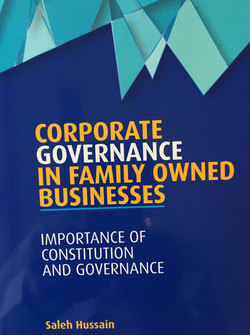Corporate Governance in Family Owned Businesses

Реклама. ООО «ЛитРес», ИНН: 7719571260.
Оглавление
Saleh Hussain. Corporate Governance in Family Owned Businesses
Author’s Note
Introduction
Chapter 1. Family Owned Business Defined
Chapter 2. Family Owned Businesses – Facts and Characteristics. 2.1. Family Owned Businesses Worldwide
2.2. Family Owned Businesses in the Middle East
2.3. Features of FOBs in the Middle East
2.4. Family Owned Businesses in GCC
2.5. Stages of FOB – Ownership and Common Issues
Chapter 3. Challenges and Opportunities for FOBs. 3.1. Challenges & opportunities for FOBs in GCC
3.2. SWOT ANALYSIS
3.3. Opportunities and Challenges for FOBs. 3.3.1. Opportunities
3.3.2. Challenges. 3.3.2.1. Segregation of Ownership and Management
3.3.2.2. Segregation of Financial Relationships
3.3.2.3. Corporate Governance
3.3.2.4. Absence of Internal Audit:
3.3.2.5. Difficulty in Monitoring Growth and Attracting New Shareholders:
3.4. Important Issues for Improving the CG policies for FOBs. 3.4.1. Succession Planning
3.4.2. Employment within FOBs
3.4.3. Equal treatment of other shareholders
3.4.4. Meetings
3.5. Specific Suggestions for Enhancing CG Practices within FOBs. 3.5.1. Appointment of a Strong and Effective Board of Directors
3.5.2. Formation of High Level Policies
3.5.3. Formation of Family Councils and Advisory Boards
3.5.4. Conflict of interest and roles
3.6. Family Businesses vis-à-vis Non Family Businesses
3.6.1. Advantages:
3.6.2. Disadvantages:
3.7. Family Governance Structure
Chapter 4. Corporate Governance for FOBs
4.1. Benefits to FOBs
4.2. Benefits of CG to the Country
4.3. Importance of a CG code
4.4. Corporate Governance Code
4.4.1. Introduction
4.4.2. Principles of CG
4.4.3. Organization Chart / Governance Structure
4.4.4. Board of Directors
4.4.5. Board Committees
4.4.6. Board Secretary and Board Committee Secretaries
4.4.7. Board Members Induction and training
4.4.8. Board and committee annual performance evaluation
4.4.9. Board compensation and remuneration
4.4.10. Succession Planning
4.5. Shareholders
4.5.1. General Annual Meetings / General Assembly:
4.5.2. Minority Shareholders
4.5.3. Dividend Policy
4.6. Control aspects
4.6.1. Internal Audit and Internal Control
4.6.2. Compliance
4.7. External Audit
4.8. Disclosure and Transparency
4.9. Code of Conduct
4.10. Internal Audit
4.11. Enterprise Risk Management (“ERM”)
4.11.1. Benefits of Enterprise Risk Management
4.11.2. Responsibilities of the Board Towards Enterprise Risk Management
4.12. Policies supporting CG Practices
4.13. Family Advisory Board
4.13.1. Role of the Advisory Board
4.13.2. Advantages and disadvantages of Advisory Boards
Chapter 5. Family Constitution
5.1. Why Family Constitution
5.2. How A Constitution Is Prepared
5.3. Definition and Purpose
5.4. Constitution Contents
5.4.1. Introduction about the constitution, family and purpose
5.4.2. Names of family members included in the constitution
5.4.3. Objectives and values of the family
5.4.4. Companies, properties and Ownership Structures
5.4.5. Family Board of Directors
5.4.6. Management of Business Units
5.4.7. Terms and conditions for ownership changes in the family businesses (e.g. opting out, buying shares from other family members etc.)
5.4.8. Terms of ownership of companies outside family businesses
5.4.9. Rights and obligations of family members (in regards properties, investments, cash and deposits)
5.4.10. Terms of evaluating the shareholding of Family Members
5.4.11. Family programs for social and charity causes
5.4.12. Family members training and development fund
5.4.13. Profit sharing and dividends payments
5.4.14. Employment terms for family members within family businesses
5.4.15. Family Assembly
5.4.16. Family Council
5.4.17. Family Office
5.4.18. Voting terms
5.4.19. Family Committees
5.4.20. Representation of family members on boards of companies of the family and companies with shareholding outside family business
5.4.21. Succession Planning
5.4.22. Management of inheritance issues
5.4.23. Terms of dispute resolution
5.4.24. Conflict of Interest
5.4.25. Family Philanthropy / charity activities
5.4.26. Internal and External Control
5.4.27. Other issues…
5.4.28. Revision of the family constitution
Chapter 6. Going Public Option – Is it a solution or a problem?
6.1. Introduction
6.2. Prerequisites for going public
6.3. Advantages
6.4. Disadvantages
6.5. Steps to be taken to prepare for going public
6.6. Going Public Plan
6.7. Examples of MENA “FOBs” that have gone public
Chapter 7. Corporate Social Responsibility
8.1. Clarity of Purpose
8.2. Formation
8.3. Target stakeholders
8.4. Interest Groups’ Role
8.5. Activity Reporting & Communication
8.6. Audit
8.7. Social Responsibility and World Financial Crisis
8.8. Role of CSR
8.9. Top 10 CSR Initiatives Worldwide
8.10. Examples of CSR good practices by FOBs in GCC
Appendix 1: AlFetaihi – KSA – A Success Story
Appendix 2: Sample of Arbitration Committee Charter
Appendix 3: Abbreviations
Appendix 4: References
About the Author
ABOUT THE BOOK
Отрывок из книги
My journey with Corporate Governance started in 1998, when asked by my son Esam, who was then studying in United Kingdom for his MBA, to help with providing reference materials on the subject. Reacting to that request, and in fact reacting to the new terminology of Corporate Governance (“CG”), prompted a desire to investigate the meaning and application of CG. I read then good number of research papers on the subject. In 1999 and 2000 I attended an annual conference called International Corporate Governance Conference at Henley Management College, currently known as “Henley Business School”. I continued to attend the conference on annual basis until 2002/3.
During the years I attended those conferences I met Prof Chris Mallin, who has active interest in the subject. We discussed the issue at length and agreed to undertake a field study on “Corporate Governance in the listed Companies in Bahrain. I did the field- work, collected the data and information and sent to Prof. Mallin for analysis. The paper was published in 2002 under the joint names of Prof. Chris Mallin, University of Birmingham and Saleh Hussain. Corporate Governance: An International Review, Vol. 10, pp. 197-210, 2002
.....
•The need to shift from purely operational to thinking in more strategic terms.
•Proper separation of management and ownership.
.....